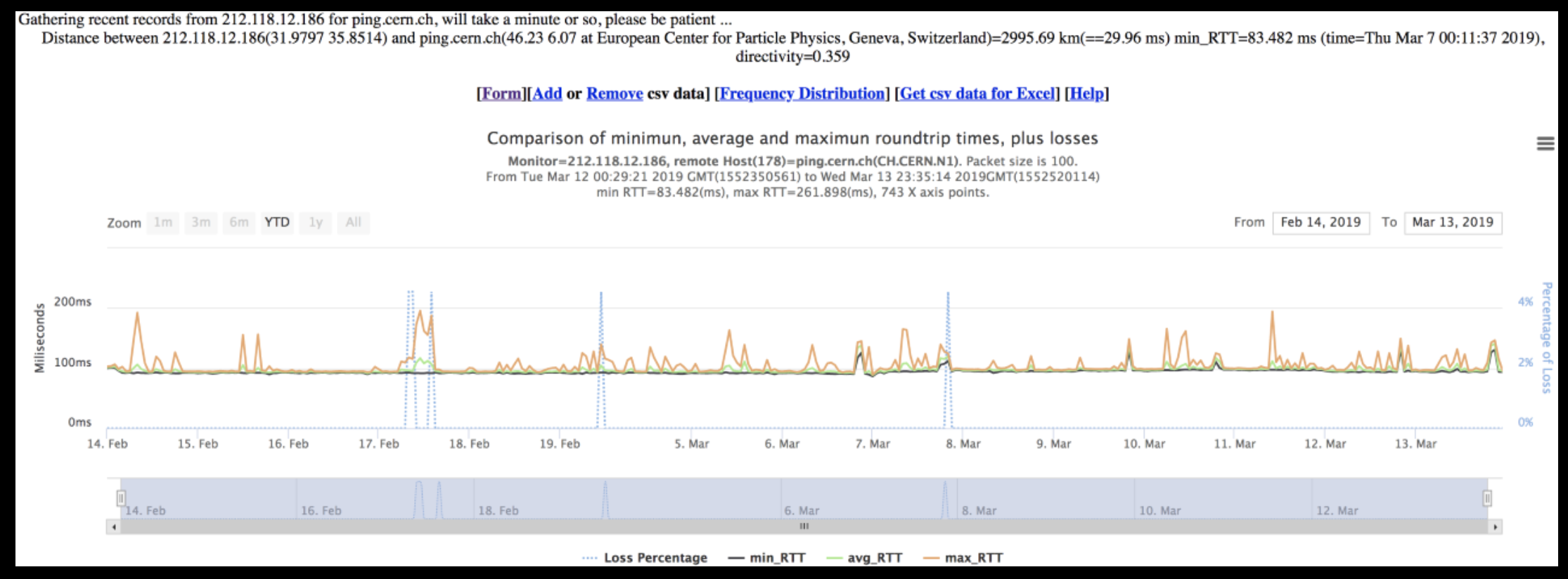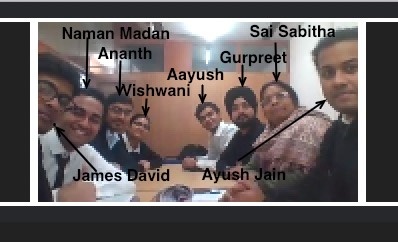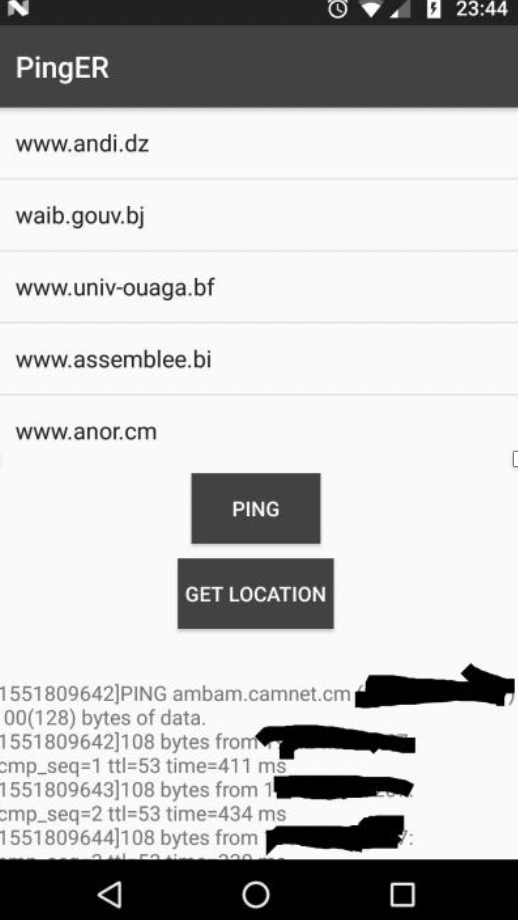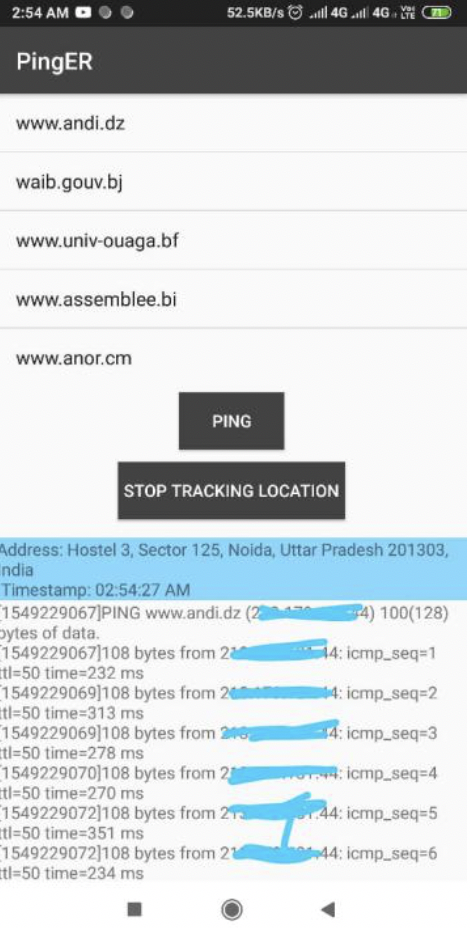Time & date
This meeting: March 14th, 10 pm Pacific time (Nb now on summer time); a day later 10:00 am Pakistan time; 10:30 am India time; 1:00 pm Malaysian & Guangzhou time; 12:00 pm Thailand time; 7:00 am Jordan and 6:00am Turkey.
Doodle poll invites sent.
Format
New items and updates are in boldface. Action/discussion items are in red
Coordinates of team members:
Mailing list: pinger-my@googlegroups.com for membership see https://groups.google.com.
- Invitation to Saif A. Kazakzeh (xsaifahmadx@gmail.com) of Jordan still pending, awaits Saif response
Attendees
Invitees:
Wajahat Hussain+ (SEECS), Saqib+ (GZHU); Johari (UNIMAS); Adib (Turkey); Dr. Charnsak Srisawatsakul+ (Ubru), Eyad Ayoubi (Jordan), Baraa Muslmani- ( Jordan), Dr. Shadi Jawarneh (Jordan), Bebo White+, Umar Kalim+, Les Cottrell+
- + Responded via Doodle will attend; - Responded, but unable to attend on this date; ? extra email sent asking if attending
- Email addresses (all the following are in pinger-my).
- cottrell@slac.stanford.edu; wajahat.hussain@seecs.edu.pk; saqibutm@outlook.com; johari.abdullah@gmail.com; adibhabbal@karabuk.edu.tr; charnsak.s@ubru.ac.th; eyadayoubi@gmail.com; b.muslmani@yahoo.com; shadi.jawarneh@yahoo.com; bebo@slac.stanford.edu; kalim@slac.stanford.edu
Actual Attendees
Bebo, Saqib, Les
Others
Administration
- Set up email list pinger-am@googlegroups.com in https://groups.google.com for the Amity PingER team including Aayush Jain, James David, Naman Madan, Dr Sai Sabitha. Sent invites 1/26/2018.
- This meeting was scheduled with the aid of a Doodle poll sent 3/3/2019.
- It was by Zoom
Use of Zoom
IMPORTANT NOTE: The meeting is set up to record automatically. By joining the meeting you are agreeing to be recorded. (see details.
Also, note that daylight savings time will kick in on Sunday 3/10. Therefore, please consult the time conversion table here.
What: PingER Standing Meeting
When: Mar 14, 2019, 10:00 PM Pacific Time (US and Canada)
Where: Join from PC, Mac, Linux, iOS or Android: https://stanford.zoom.us/j/201093085
How to set up and use Zoom:
To use the software, you would have to download the Zoom client (and installed if prompted). The instructions to do so are listed here: https://zoom.us/download#client_4meeting
The instructions about setting up the software are listed at the URL below. You may want to create an account if you do not have one already. If you are invited to a meeting (i.e., you are not hosting the meeting), you are not required to create an account; you can simply join the meeting using the meeting ID.
https://support.zoom.us/hc/en-us/articles/201362033-Getting-Started-on-PC-and-MacJordan (Updated 3/6/2019)
We had a Zoom meeting with Eyad and Baraa of the Jordan team.
- They installed the PingER traceroute server, the data gatherer (ping_data.pl) and the Measurement Agent (MA, pinger2.pl).
- Les updated the web page on requirements.
- It was working for about a week, then the pinger.xml was corrupted (possibly due to an invalid link to the BeaconList update file at SLAC). Baraa fixed pinger.xml.
- It is working again as of 3/5/2019.
- Baraa is interested in monitoring other Jordanian hosts. There are 4 other targets in Jordan. They are:
- http://www.slac.stanford.edu/cgi-wrap/dbprac.pl?alias=JO.NEXT.WWW&monalias=EDU.SLAC.STANFORD.PINGER
- If there are other sites in Jordan that should be monitored from say SLAC and Jordan please let Les know the details and he can add them to the PingER Oracle NODEDETAILS database, so they are monitored from SLAC. If they are to be monitored from Telephoenics then they will need to be added to the <HostList>stanza of the Telephoenics pinger.xml.
- Eyad has moved to Instanbul Turkey. After he has settled down he will be looking to do a PhD in Turkey. He will look at installing a PingER MA there. Emailed Eyad 3/14/2019 requesting update.
Turkey
Amity (Updated 3/3/2019).
Amity team photo:
The following are the data analysis projects:
- Title (tentative): Correlation Analysis between network performance and GDP of a country using PingER data. Abstract (tentative):
This paper aims towards finding the correlation between Gross domestic product (GDP) of a country and it’s network performance (ping analysis)
using PingER data. Email ID: Naman Madan, naman.madan25@gmail.com - Title (tentative): Comparison of network performance of India and Pakistan using PingER data. Abstract (tentative):
This paper aims at comparing the network performance of India and Pakistan using the PingER network performance data of 2-3 years of both the countries and applying clustering to the year-wise data. Comparing the number of components in each cluster will help in concluding the quality of the network performance. More the number of the components, with the least average RTT, better the performance. Email ID: Vishwani Sati, vishwani.sati@gmail.com - Title (tentative): Data packets loss prediction due to environmental factors.
Abstract (tentative): Pinger data losses during certain environmental factors like – Earthquakes, heavy rainfalls, Tsunamis etc, are a major concern for the big companies, delay of few seconds will lead to huge customer breakdown. To deal with this situation, we will analyze the data losses trend with respect to the external environmental factors and will predict the data losses beforehand so that company will have upper hand if some crises stricks in future. We will analyze the Pinger data and environmental conditions attributes and will make an algorithm that will predict the losses in pinger data. Email: Gurpreet Singh, gurpreetn92@gmail.com.
Android progress:
- Instructions from Aayush to load the application are at ePingER Functional prototype (for Androids only)
- Topher was able to make the prototype work on an android phone prior to our last call. They might have an updated app, in which case he can further test it, but he’d need to know where to get it. He offered to put it in android phone and drop it off for you at SLAC where we can also test it, in early February.
- Email sent to Amity 1/27/2019 asking if there is a newer version of the App.
- We will use the amity anonymous FTP server to gather the data.
- They will add the GPS coordinates (lat/long) to the MA data. This will enable looking at mobile PingER measurements.
- We have requested (emails 3/6/2019, 3/15/2019) to know how the extra information on lat/long will be added to the records (I.e. the format of the android records) since accommodating that will require changes in the gathering/storage/analysis to be backward compatible. Thus it needs to be algorithmically simple to identify and extract the extra information. For example providing a simple separator between the old data format and the new extra lat/long data, such as a semi-colon.
Work Flow for the PingER App
1. The user opens the application. The layout consists of a ListView displaying the hardcoded IP addresses from the SLAC website along with two buttons- one to ping the beacons and the other to get the location of the user.
2. On Clicking the “Ping” Button each of the hardcoded IP addresses is pinged and the output is displayed on the screen.
3. On Clicking the “Get Location” button the current location of the user is displayed. Google Geolocation API is used to implement this feature.
Flowchart of the Application
Bebo will contact Topher, and look at installing on a spare Android at Bebo's home in San Francisco. We could also do that at SLAC.
- Topher will get us some Android phones when he gets back. Topher is in Ecuador at the moment, he and Bebo will be meet in April.
- At this time Topher will install the latest version of the App in the Androids
- Les will contact Amity to see if they will have an update to the Android/Pinger by 2nd week in April. Ideally, such an update would include the location information for the MA when the measurement is made. Email sent to Amity 3/15/2019:
- Topher (the person with the Android phones) is currently in Ecuador and he and Bebo will meet early April. At that time Topher will install the latest version of the Amity Android/PingER MA App in some Android phones for testing and evaluation. Thus it would be helpful if you could aim for say Monday, April 8th, 2019 for a release of the App.
As I mentioned 3/6/2019, it would be good to make the following addition to the App:To track measurements made by a mobile device requires one to know its location at the time of the measurement. This information needs to be recorded together with each measurement. We need to decide how the extra information on lat/long will be added to the records (I.e. the format of the android records) since accommodating that will require changes in the existing gathering/storage/analysis to be backwards compatible. It needs to be algorithmically simple to identify and extract the extra information. For example providing a simple separator between the old data format and the new extra lat/long data, such as a semi-colon. This new location data might be appended at the end of each current measurement following the semi-colon.
- Topher (the person with the Android phones) is currently in Ecuador and he and Bebo will meet early April. At that time Topher will install the latest version of the Amity Android/PingER MA App in some Android phones for testing and evaluation. Thus it would be helpful if you could aim for say Monday, April 8th, 2019 for a release of the App.
Adib (Updated 3/3/2019)
- Adib moved to Karabuk University in Turkey where he is an Associate Professor.
- The time difference would probably require a change in meeting time (e.g. 10:00 pm SLAC = 6:00 am Turkey)
- He will discuss with the department head about installing a PingER MA there.
- Regarding the paper, it has been submitted to Journal: Computer Communications
Title: Socio-economic Development Indices and Their Reflection on Internet Performance in ASEAN Countries
Corresponding Author: Adib Habbal
Co-Authors: Les Cottrell, Emmanuel Mkpojiogu, Bebo White, Suhaidi Hassan, Faisal Zulhumadi Unfortunately, it was rejected.
Adib, Bebo and Les are looking for another journal, some possibilities include: https://webscience-journal.net/webscience,https://www.journals.elsevier.com/business-horizons, https://www.journals.elsevier.com/government-information-quarterlyAdib is wondering about- Journal of Computer Information Systemshttps://www.tandfonline.com/action/journalInformation?show=aimsScope&journalCode=ucis20
- The Information Societyhttps://www.tandfonline.com/action/journalInformation?show=aimsScope&journalCode=utis20
Bebo reviewed and responded to Adib suggesting the second one is a better choice. Adib will submit it to the 2nd journal.
NUST: (Updated 3/3/2019)
Wajahat raised the topic: We also need to formulate some research problems that have the potential of appearing in some well-known places. This might help in attracting NUST students which is getting harder these days. I need your help in this regard.
Discussion . (Wajahat was this useful? Is there something else? Email sent 3/15/2019):
- There is a web page at Future PingER Projects which was last updated July 2018. Topics that currently stand out include:
- Applying Blockchain to PingER data, see the paper by Saqib, here.
- Graphical traceroute maps. Note currently when one looks up the location of a router, it usually gives the location of the home site that is managing the routers, e.g. ESnet routers in the US and Europe are all identified as being at LBL. Using ping minimum RTTs to a router from multiple sites (e.g. the perfSONAR traceroute servers in the US, Canada, and Europe, see http://www.slac.stanford.edu/comp/net/wan-mon/viper/tulipmap.html) one can use trilateration to identify the location of the router. Earlier work on this can be found at http://www.slac.stanford.edu/comp/net/tulip/
- Deploying Android/Pinger devices, understand how their low cost (cheap enough to be disposable), low power (e.g. use of solar power) and potential mobility may be used, i.e. the risks, mitigations, and benefits.
- Linked Open Data applied to PingER data.
- Using PingER data as a source of big data to search anomalies, trends etc.
- Case studies, e.g. can one identify the impact on networking of social unrest such as the current Venezuala difficulties, or of other events such as earthquakes or Tsunamis.
- I have increased the number of working Venezuelan target hosts monitored from SLAC from 3 to 8, to possibly assist in this.
- Another interesting case study would be to look at the impact of hurricanes on Internet connectivity in say the Caribbean, see for example Hurricanes Irma and Maria 2017.
- Compare and contrast IPv6 with IPv4 behavior, identify outliers and understand - Umar, Les, and Saqib are looking at this.
- Also, see PingER Papers and Presentations for some topics that have recently resulted in papers.
- Are any of these of interest?
- There is a web page at Future PingER Projects which was last updated July 2018. Topics that currently stand out include:
Saqib sent email to Wajahat:
- As discussed in the last meeting, kindly check if it is possible to get an IPv6 address in NUST for installing an IPv6 MA in PK. I will also contact PERN regarding the possibility of getting an IPv6 address.
- Wajahat is moving from one office to another in NUST. There are IPs but he has not been able to get to the right person. He will update if the situation changes. Email sent 3/15/2019 requesting an update.
UAF/GHZU (Updated 3/3/2019)
- Saqib joined the University of Agriculture in Faisalabad. He plans to pursue the blockchain paper.
- Bebo sent email, see below. Saqib will follow up.
- Not sure whether this would be relevant for PingER work - maybe Saqib's blockchain paper? I'm not sure that there has been much discussion re: PingER security - thoughts? The submission is due May 24th
Bebo- From: Security and Communication Networks <scn@journals.hindawi.com>Sent: Monday, February 25, 2019 11:58 PM
To: White, Bebo
Subject: Special Issue: "Cryptography and Security Tools and Techniques for Networked Embedded Systems"Dear Dr. White, We are currently accepting submissions for our upcoming Special Issue titled
"Cryptography and Security Tools and Techniques for Networked Embedded Systems," which will
be published in Security and Communication Networks in October 2019. The Special Issue is open to both
original research articles and review articles, and the deadline for submission is May 24, 2019.
You can find the Call for Papers at https://www.hindawi.com/journals/scn/si/136986/cfp/.
Security and Communication Networks is a peer-reviewed journal published by Hindawi
as part of a publishing collaboration with John Wiley & Sons (https://www.hindawi.com/wiley.hindawi/).
Starting January 2017, the journal has been converted to a fully open access publication, which
means that anyone can access it online without a subscription and authors retain the copyright of their work.
The most recent Impact Factor for Security and Communication Networks is 0.904 according to Clarivate Analytics' l
atest Journal Citation Reports. The journal's most recent CiteScore is 1.36 according to the latest
CiteScore metrics released by Scopus. Please read over the journal's author guidelines at
https://www.hindawi.com/journals/scn/guidelines/ for more information on the journal's policies and
the submission process. Manuscripts should be submitted online to the Special Issue at
https://mts.hindawi.com/submit/journals/scn/adcsc/.
Please do not hesitate to contact me if you have any questions. Best regards, Rana Khaled
- From: Security and Communication Networks <scn@journals.hindawi.com>
- Not sure whether this would be relevant for PingER work - maybe Saqib's blockchain paper? I'm not sure that there has been much discussion re: PingER security - thoughts? The submission is due May 24th
Thailand (No update 8/9/2018, No update 9/6/2018, No update 11/19/2018, 1/15/2019, 2/12/2019, no update 3/14/2019)
Charnsak is looking at a host in Champasak University, Chan Parsa province in Laos as a potential site for a PingER MA. Charnsak just got approved to make contact with the Champasak University. He expects to set up the MA in the next 4-5 months (say towards end 2018). It also depends on the partner university, and there may be a lot of paperwork.
Email requesting update sent 12/6/2018, 3/15/2019.
UNIMAS (No update 8/9/2018, no update 9/6/2018, no update 10/7/2018, no update 11/19/2018, 12/11/2018, 1/15/2019, 2/12/2019, 3/14/2019)
Need to add Umar Kalim to http://pinger.unimas.my/pinger/contact.php. From the 7/5/2018 meeting: Johari can't ssh into the server so he will go to it on Monday. He will also upload the new UNIMAS PingER website next week.
Sent reminder emails 8/6/2018. 9/3/2018.
PingER at SLAC
At Bebo's suggestion, Les put together on the Impact of last year's hurricanes Irma and Maria on the Carribean Internet connectivity, see Hurricanes Irma and Maria 2017
| Host | State | last seen | Status |
|---|---|---|---|
| pinger.cs.ubru.ac.th | Stopped being pingable 2/25/2019. Thus by default the gathering failed. However, by ignoring the ping result gathering works to http://pinger.cs.ubru.ac.th/cgi-bin/ping_data.pl. Fixed gatherer script and gathered missing data. 3/2/2019 sent email to Charnsak asking if the pinging can be fixed. It appeared to be fixed 4/3/2019. | 2/25/2019. | Ping fails but gathering works. |
| pinger6.cs.ubru.ac.th | Stopped being pingable 2/25/2019. Thus by default the gathering failed. Gathering also fails to http://202.29.20.125/cgi-bin/ping_data.pl . Emailed Charnsak 3/4/2019, 3/15/2019. | 2/25/2019 | |
| pinger.cs.ubru.ac.th | Unable to gather data. Not pingable by name or address. Emailed Charnsack 3/15/2019. | 3/13/2019 | |
| pinger.isra.edu.pk | Down, it came up Sep 2-4, 2018. It is pinging, however, all the targets are not responding after 31 tries, email sent to Wajahat 9/18/2018. As of 10/14/2018 it is not pingable. Working again as of 1/5/2019. It started again1/26/2019. It does not respond to pings from SLAC but does respond to http://pinger.isra.edu.pk/cgi-bin/ping_data.pl? which is used to get the data. However, the data indicate that none of the pings respond, e.g. pinger.isra.edu.pk 121.52.154.228 pinger.fsktm.um.edu.my 103.18.2.152 100 1548633600 31 0i.e. all 31 pings fail and 0 give any response. When one tries to ping from pinger.isra.edu.pk using http://pinger.isra.edu.pk/cgi-bin/traceroute.pl?function=ping&target=www-wanmon.slac.stanford.edu&options=-i%200.2 the web page responds but all pings from isra fail. Email sent to Wajahat 1/28/2019. Started working again 1/30/2019. Stopped being pingable and unable to gather data 2/11/2019. 3/2/2019 can gather data but all the pings are failing. This is not a normal failure mode. Emailed Wajahat 3/3/2019, 3/15/2019. | March 6, 2018 | Fixed 1/5/2019 Failed again starting 1/26/2019. Working again 1/30/2019 |
| monitor.seecs.edu.pk | results{monitor.seecs.edu.pk}[0] not defined, unable to gather data for 11 consecutive days this month Skipping monitor.seecs.edu.pk(5) does not ping by name or address 111.68.101.10, email sent to Wajahat 1/26/2019, 2/3/2019, 3/3/2019. It started working again 3/5/2019. | 1/14/2019 | Working again 3/5/2019. |
No update to the following 3/14/2019.
Context:
- Is there any statistical difference between ICMP and TCP Ping? The context here is the Internet (not data center). This is important because the network stack is different (e.g., MPI over infiniband) and latencies are significantly less.
Questions:
- Why should we focus on minimum RTT instead of average RTT
- Min RTT essentially reflects fixed delay, while average RTT subsumes variations and path load
- Link to raw results with minRTT results:
- Are the R plots generated using minRTT?
- Averages and computed. Min RTT is available. Scripts need to be updated to use minRTT.
- What is the breakdown of latency between endpoints? If there is a difference, is it because of the type or location of the source? What if the source of traffic was not SLAC? Is there a correlation with the distance between the endpoints?
- Latency for an echo packet to travel up the stack and back down is about 3.75 micro seconds (see StackMap https://www.usenix.org/conference/atc16/technical-sessions/presentation/yasukata). As expected, this is negligible when considered with milli second latencies.The remaining components would be propagation and queuing delay. As we can not breakdown the two in a public network without using an active look like
- To replicate use system tap. See: https://unix.stackexchange.com/questions/419449/how-can-i-determine-if-a-latency-is-due-to-a-driver-or-the-scheduler
- pathchirp etc, we'll continue to consider these as a single component.
- Latency for an echo packet to travel up the stack and back down is about 3.75 micro seconds (see StackMap https://www.usenix.org/conference/atc16/technical-sessions/presentation/yasukata). As expected, this is negligible when considered with milli second latencies.The remaining components would be propagation and queuing delay. As we can not breakdown the two in a public network without using an active look like
- Are the differences limited to a particular region? How do we determine/understand if traffic prioritization is implemented? Test in a controlled environment to avoid variables such as traffic prioritization, queuing delay due to cross traffic. Review the time series of latencies for both ICMP and TCP ping, instead of averages?Is there a difference between IPv4 measurements vs. IPv6.
- It may be that end hosts which are farther away have larger variances and thus the pronounced differences.
Next Meeting
Next meeting: There will be a Doodle poll, April week 15th-18th 10 pm Pacific time; a day later 10:00 am Pakistan time; 10:30 am India time; 1:00 pm Malaysian & Guangzhou time; 2:00 pm Thailand time; 7:00 am Jordan time. 6:00am Turkey time. Any thoughts on time of day.




